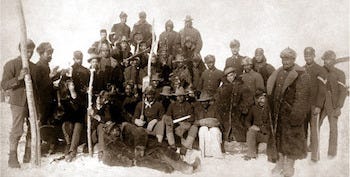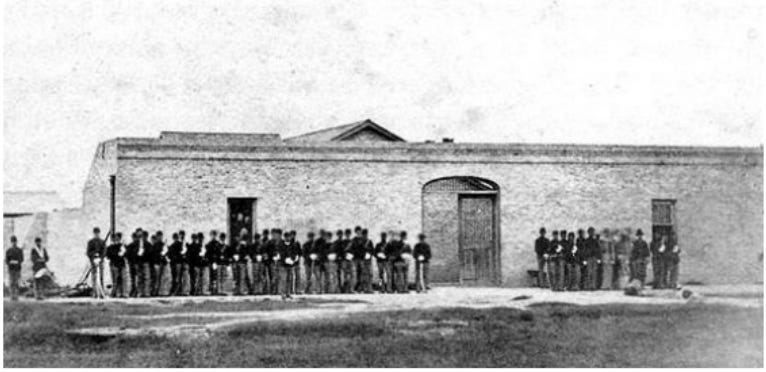On This Day: The Brownsville Affair of 1906
How a single night of gunfire in Texas led to mass injustice against 167 Black soldiers, and a fight for the truth that lasted more than half a century.
A night of gunfire, injustice, and a fight for truth that lasted decades
In the early hours of 13 August 1906, the small border town of Brownsville, Texas, was gripped by fear. The night air hung heavy with humidity, the kind that clings to your skin and slows every movement, but on this night the stillness was shattered by gunfire. It was a sound that would echo far beyond the dusty streets of Brownsville, leaving a scar on the history of the United States Army and igniting a controversy that would take decades to resolve.
Mayor Fred Coombe had been roused from his rest with news that something terrible had happened in the town centre. In a time when the horse-drawn wagon was still the quickest way to reach an emergency, he raced down the main street with urgency etched on his face. The moonlight offered only faint guidance as his horses galloped on, their hooves pounding the earth in a rhythm that matched his own quickening heartbeat.
The scene that greeted him was not one of bustling saloons or the quiet glow of hotel lamps. Instead, windows were dark, doors bolted shut, and curtains twitched as wary eyes peered out. Just hours earlier, laughter and conversation had filled these same streets. Now, silence was broken only by hurried whispers and the uneasy shifting of those who had come to investigate.
As Coombe pulled up to a knot of police officers standing rigid in the centre of the street, he stepped down and pushed through them. One officer was clutching his arm, blood seeping between his fingers. Another stood over the lifeless body of Frank Natus, a young bartender who had been caught in the crossfire of the violence.
Coombe removed his hat and held it to his chest, bowing his head in respect. When he raised his eyes again, he demanded to know what had happened. The answers came all at once, a tangle of accusations and fear. The officers insisted that the gunfire had come from members of the 25th Infantry Regiment, an all-Black unit of the United States Army stationed at nearby Fort Brown.
The accusations and the climate of the time
The men of the 25th Infantry were Buffalo Soldiers, veterans of military campaigns who had served the country with distinction. Yet in 1906, in the deep racial divisions of the American South, their presence in Brownsville was met with hostility by many of the town’s white residents. Segregation was the law, prejudice was an everyday reality, and suspicion towards Black soldiers was never far below the surface.
Witnesses claimed that on that humid August night, soldiers had slipped into town under cover of darkness and opened fire, injuring a police officer and killing Natus. The soldiers denied it entirely, insisting they had been in their barracks all night. There was no physical evidence to link them to the shootings, and even the spent shell casings that were presented as proof were questionable.
Yet the mood in Brownsville was against them from the start. The mayor, under pressure from townsfolk, relayed the accusations up the chain of command. Soon, the matter reached the desk of President Theodore Roosevelt.
A decision that shocked the nation
Rather than conduct a full and impartial trial, Roosevelt acted swiftly. In November 1906, just three months after the shooting, he ordered the dishonourable discharge of 167 Black soldiers from the 25th Infantry. Every man, from seasoned sergeants to the newest recruits, was dismissed without pension or the possibility of future service. They were accused collectively of conspiracy and covering for the real culprits, even though no individual had been identified as guilty.
The decision was defended by Roosevelt’s administration as necessary to preserve discipline and order. To many others, however, it was a travesty of justice. The soldiers had been denied the opportunity to defend themselves, their military records wiped away in an instant.
The human cost
For the men of the 25th Infantry, the impact was devastating. Military service had not only been their livelihood, it had been their pride, a rare avenue of respect and advancement for Black Americans in the early 20th century. Now, with dishonourable discharges, they were branded as criminals in the eyes of the public.
Many struggled to find work. Families who had relied on their steady income faced hardship. Some men carried the stigma for the rest of their lives, despite maintaining their innocence until their dying day.
What made the injustice sting even more was the fact that evidence later emerged casting serious doubt on the accusations. Some townsfolk had admitted privately that they had not seen the shooters clearly. Others suggested that the gunfire had come from civilians, possibly in a drunken dispute, and that the soldiers had been convenient scapegoats.
A long fight for justice
The Brownsville Affair, as it came to be known, became a rallying point for civil rights leaders. Newspapers serving Black communities campaigned for the soldiers’ reinstatement. Politicians, clergy, and veterans’ groups demanded a review of the case.
Yet for decades, successive governments refused to overturn Roosevelt’s decision. It was not until the 1970s, nearly seventy years later, that a formal investigation by the United States Army concluded that the soldiers had indeed been innocent. In 1972, President Richard Nixon signed legislation to restore their honourable discharges. Sadly, by that time, only two of the original men were still alive to see their names cleared.
For the descendants of the 25th Infantry, the reversal was bittersweet. It could not undo the years of hardship or erase the prejudice they had endured, but it was an acknowledgment that the truth had finally been recognised.
Lessons from a dark night
The events of Brownsville remind us that justice is not always swift, nor is it immune to the pressures of prejudice and politics. In 1906, the voices of 167 men were drowned out by a chorus of suspicion. Evidence was twisted to fit a narrative that society at the time was all too ready to accept.
What happened in those humid early hours on the streets of Brownsville may never be known with complete certainty, but what is beyond doubt is that innocent men were punished without fair trial. The incident stands as a cautionary tale about the dangers of collective guilt and the need for evidence over assumption.
More than a century later, the Brownsville Affair remains a stark example of how institutional decisions, made in haste and shaped by bias, can ruin lives. It also serves as a reminder that truth, while sometimes slow to emerge, can eventually prevail through persistence and determination.
Remembering the 25th Infantry
When we look back on the Brownsville Affair, it is not simply a tale of an unsolved crime. It is a human story about service, sacrifice, and the enduring fight for dignity. The men of the 25th Infantry had worn the uniform of the United States with pride. They had stood ready to defend a country that did not always defend them in return.
In the end, their story is one of resilience. Stripped of their ranks and cast out without honour, they held firm to their innocence. It took decades, but their names were cleared, their service acknowledged, and their honour restored.
The Brownsville Affair is part of history’s long ledger of injustice, but it is also a testament to the belief that truth matters, even if it takes a lifetime to be heard. On 13 August 1906, a night of fear and confusion set in motion a tragedy of lost years, but it also sparked a fight for justice that refused to fade into silence.



